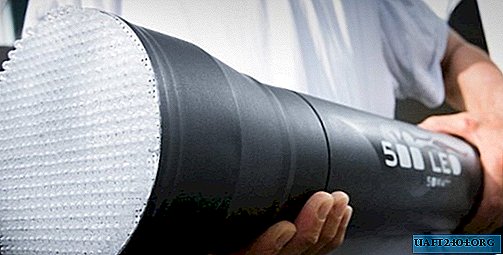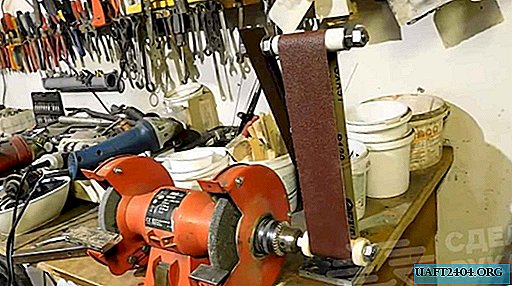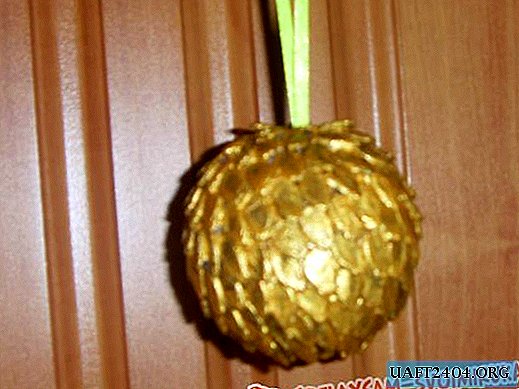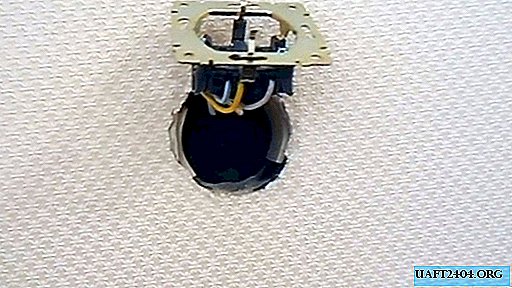Share
Pin
Tweet
Send
Share
Send
And all the more interesting is the homemade product that we want to introduce you today. It was made by the author 10 years ago, and as he himself admits, it can be modernized taking into account modern components. However, the original model is working properly and pleases its owner with a rather powerful and long glow. What is so special about her? Let's take a look together.

Device specification
- 513 LEDs 5 mm (series of three);
- Lead-acid battery 12 V / 7 Ah;
The LED panel is assembled on a conventional breadboard, with sequential soldering of all elements. You can adjust it in shape yourself using a hacksaw for metal, a paint knife or a grinder. The diameter of the disc is 13 cm.







For the device controller, mechanical DC relays 892-1Cc-C 12V 5A DC, resistance and transistors were used. As the body, you can use sewer pipes and fittings.



Device specifications (at full power)
- The magnitude of the luminous flux - 3500 - 4000 lumens;
- Recharge the battery for 10 minutes;
- Power consumption 53 W (including power consumption of the resistor 3 W).
Control Features
- Various brightness settings achieved by powering a different number of LEDs;
- Safety voltage switch to prevent discharging of lead-acid battery;
- The ability to recharge the battery without removing it from the case.
Assembly Specifications
On / Off and protection system
The first switch activates the "system / charger" mode. Here we can choose to use a battery to recharge it or to use a flashlight. When the device is charging, the flashlight is completely turned off by means of a six-pin switch. In recharging mode, you can activate the operation of the flashlight switch "on / off". On the back there are several LEDs. The first green LED lights up when there is power in the flashlight system. Thus, the "system / charger" switch is switched to the "system" mode, and the "on / off" switch is set to the "on" position.
But the LED panel is not yet operational. A safety module is provided to protect the lead-acid battery from over-discharge. The automatic voltage switching circuit is responsible for this, and the second green LED under the label "safety ok" signals. When it lights up, this means that everything is in order and the voltage is normal, i.e. above the minimum. There are three buttons for the protection system:
- No. 1 Green button "safety on / off" - activates the protection system;
- No. 2 Black button (below green) - disables the protection system;
- No. 3 The black switch "override" - redefinition of food.
When the protection is activated, the front LEDs will turn off and the voltage will drop to a certain rating. If it reaches a minimum, the protection system will stop. You can start it again by holding the green button. The low LED will indicate a low charge.
When the third button-switch is activated, power is supplied, bypassing the protection system, and the flashlight can be used even at low voltage. But the battery discharge will now have to be controlled in manual mode. When the switch is active, both the safety ok and low voltage indicators are still working. Overriding can be convenient if your battery is not fully charged, but there is enough charge left in it. If you use all the LEDs ("phase 3"), due to leakage to the battery, the voltage drops by about 1 volt. Thus, protection can be active in standby mode, but it will be disabled when used. And when the switch is active, you can notice how the protection turns on and off without loss for the LEDs. When you use the flashlight at full power, check the protection activity after turning off the LEDs for a couple of seconds. If the protection does not activate even after turning off all the LEDs, this means that the battery charge is too low and is not suitable for its safe use. When using the flashlight for a long time in the "phase 1" (3 LEDs) or "phase 2" (100 LEDs) modes, it is recommended not to use override, as you can easily forget to turn off the flashlight on time.
When power is supplied to the LED switches, the third LED on the “led system on” panel lights up. In the photo we can see that the "override" switch is active (the fourth yellow "override" LED is on). In this case, the voltage is below the minimum value, because the "safety ok" LED is off, and the "low voltage" LED is lit in red. Please note that the black safety off button will not work if the override switch is active. Thus, the voltage monitoring circuit will always display the state of charge of the battery.

Various brightness settings
There are three different LED brightness settings in the flashlight. They are indicated by the switches "phase 1", "phase 2" and "phase 3".
The "phase 1" mode implies the glow of only three LEDs. The operation of the flashlight in this case becomes very long, on a single charge it can last more than one day, but it shines like a regular inexpensive LED flashlight on AA batteries.
The "phase 2" mode includes 100 LEDs, and the "phase 3" - the entire platform. The modes are switched by the corresponding buttons on the panel, and they can be used both individually and in various combinations. When the "phase 3" mode is on, the remaining modes remain activated. These adjustments are possible due to the presence of a relay in the circuit. Opposite each of the fixed mode switches are buttons for their short-term inclusion, duplicating these modes. Alternating the positions of switches and buttons, individual combinations of LED activity can be used. For example, send signals in Morse code, or check the connection with the group on a hike by pressing the "phase 3" button when the "phase 1" or "phase 2" modes are on. And if you just need to consider something better in the dark, the buttons for briefly turning on the mode are what you need!



Additional external device
The control panel is completed by elements intended for an external device. To make the flashlight more versatile, the author added a fourth switch of the "phase" type and a button next to which there is a socket for the power plug of the charger "ext output". Using this button, you can turn on and off the 12V output on this connector to connect an external device. The “charger / system” switch must be in the “charger” mode to ensure that the battery is disconnected from its system. The device can be connected from any DC source to 12V. According to the author, even a small 9V battery can light this flashlight, but not at full power. You can also use a cigarette lighter to charge or operate it, since the flashlight's battery gives out only 7Ah of current, while a car battery can deliver up to 100 Ah.



Conclusion
For those who find this model of LED flashlights too complex, modern analogs of such assemblies based on LED matrices are suitable. Their power reaches 100W, the luminescence temperature is 6-10tys.k, and the light wavelength is up to 9000Lm. The brightness from such lamps, even without a reflector and a hub, is very large, and the dimensions are small. Nevertheless, the benefits are obvious, because soldering 500 LED elements is not an easy task. Instead of lead-acid batteries, lithium or polymer lithium smaller and more powerful can also be used. For the rest, this lamp is quite powerful and bright, and by its characteristics it is quite worthy of the attention of amateur craftsmen.



For more detailed assembly and testing of the flashlight, see the video clip.
Share
Pin
Tweet
Send
Share
Send











